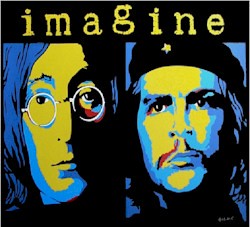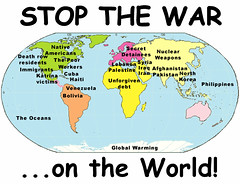Wednesday, August 16, 2006
Why don't those Palestinians just protest peacefully?
People trying to be "even-handed," and criticize Palestinians and Israelis alike, often distance themselves from the Palestinians (and Hizbollah) by asking why they don't just protest non-violently, you know, like Gandhi? Well, aside from the fact that there is no equivalence between the violence of the oppressed and the violence of the oppressor, there are very practical reasons why Palestinians eschew the "non-violent" road - because it's frequently met with Israeli violence. Rachel Corrie and Tom Hurndall are just two names well-known to those of us in the West because they were Westerners; they weren't the first and they won't be the last to be killed while protesting non-violently against Israeli actions. Now you can add the names of Rina Klauman and Lymor Goldstein to the list (fortunately not yet to the list of those who have died):
Danish and Israeli peace activist suffer health deterioration of critical wounds they sustained when Israeli Occupation Forces (IOF) attacked last Friday an anti-wall demonstration in the village of Bil'in, west of Ramallah.Al Jazeera has more details about the incident itself:
The Danish peace activist, Rina Klauman, from Copenhagen, was transferred last night from Hebron hospital to Hadasa Ein Karem hospital in Jerusalem for more extensive tests, International Solidarity Movement (ISM).
ISM reported today that Rina has small bleeding in her brain from a concussion she received when an Israeli border policeman beat her with his gun at the demonstration.
The ISM added that an Israeli activist, Lymor Goldstein, formerly of Germany is currently in a stable condition at Tel Hashomer hospital in Tel Aviv.
Goldstein was taken in for immediate surgery, which took 3 hours, and a rubber bullet as well as shards of bone and damaged brain tissue were removed from his head and an internal hemorrhage was stopped.
The injuries, Rina and Lymor Goldstein are the most serious injuries the army has caused in Bil'in since Ramzi Yassin, who was shot in the head with a plastic-coated steel bullet.
Ramzi, from Bil'in, was handing out water during a demonstration in Bil'in on July 8, 2005, when he was shot in the side of the head. The bullet caused severe bleeding of his brain and he was left unconscious for 7 days and with permanent brain damage.
An Israeli border police soldier shot a rubber-tipped bullet at a demonstrator during a protest against the separation wall in the West Bank, Israel’s Haaretz daily reported.I've quoted more extensively from these articles than I usually do. Why? Because your chances of hearing about this incident in the Western corporate media lie somewhere between nil and none.
The shooting took place during the weekly Friday protest against the seperation wall in the city of Bil’in, a small village near Ramallah, which will be deeply affected by the illegal barrier that appropriates 50% of its lands and about 70% of its cultivated area.
In violation of military rules, the rubber-tipped bullet was fired at close range, from between 10 and 20 meters, injuring an Israeli attorney, identified as Lymor Goldstein, in the head.
The Israeli military's rules allow the firing of rubber-tipped bullets at a distance of at least 40 meters, and only at the legs of the target. Rubber bullets are plastic-coated lead bullets, and they could be deadly when fired at certain areas of the body.
The Israeli Occupation Forces (IOF) said that border police forces threw stun grenades and fired rubber bullets to disperse the protestors, claiming that the demonstrators threw rocks at them.
But video footage of the incident clearly shows that the border police commander ordered his soldiers to shoot rubber bullets without warning the protestors, and before any rocks were thrown at his troops.
The footage also shows that Israeli soldiers aimed their weapons at shoulder height, directly firing at the protestors. At one point, an Israeli soldier was seen aiming his gun at two demonstrators searching for cover, and then firing at the head of one of them.



